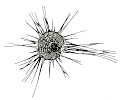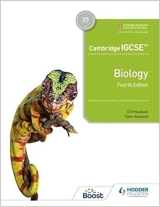Amoeba, an Introduction
The species of amoeba are single-celled animals, protozoans. They have no chlorophyll or cell walls and they take in and digest solid food. They live in ponds, ditches and other moist places, and in the soil.
Structure. The protozoans are microscopic organisms. Amoeba proteus, which is the amoeba commonly studied in the laboratory, is about 0.3 mm in diameter and the amoebae which live in the soil are even smaller. The single cell of amoeba consists of a nucleus and cytoplasm. The outer layer of cytoplasm, ectoplasm, is a clear gel while the bulk of the amoeba consists of endoplasm, which is more fluid than ectoplasm and contains granules and other minute structures.
Amoeba has no permanent shape but changes all the time especially when moving or feeding.
Locomotion. There are no special locomotory organs like flagella or cilia. Amoebae move by the flowing of their cytoplasm over the surface of the mud or soil. At one point of the amoeba the ectoplasms starts to spread out into a protuberance called a pseudopodium and the fluid endoplasm follows. In time, all the endoplasm will have flowed into the extending pseudopodium so that the amoeba is brought to a new position.
Changes of direction are effected when a new pseudopodium begins to form at another point of the amoeba's surface. The direction of movement is probably determined by local differences in the water. Slight acidity or alkalinity may cause the cytoplasm to start flowing or prevent its doing so altogether. The chemicals diffusing from suitable food material may cause the cytoplasm to flow in that direction.
Feeding. When an Amoeba encounters a microscopic plant like Chlamydomonas, pseudopodia flow out rapidly and surround it so that the plant is ingested with a drop of water into the endoplasm of the amoeba. This forms a food vacuole. The surrounding cytoplasm secretes enzymes into the food vacuole. These enzymes digest the soft parts of the plant. The soluble, digested materials are then absorbed into the surrounding cytoplasm, and the undigested residue left behind or egested, as amoeba flows on its way.
Food vacuoles with material in various stages of digestion can be seen in the cytoplasm of the amoeba. Ingestion and egestion can take place at any point on the surface; there is no ‘mouth’ or ‘anus’.
Osmo-regulation. The cell membrane of amoeba is partially permeable; with the result that the concentration of the solutions in the endoplasm causes water to be taken in. This excess water is collected up in a spherical vacuole which gradually swells, and then seems to contract or burst, liberating the accumulated water to the exterior.
Reproduction. Amoeba stops moving and its nucleus divides. The. cytoplasm then divides to make two daughter individuals This is binary fission.
In some species a cyst is formed: that is, a resistant wall is secreted round the more-or-less spherical amoeba. In this cyst the amoeba is able to resist unfavourable conditions and may be carried to other situations. The nucleus and cytoplasm within the cyst divide repeatedly so that, when it bursts open, a fairly large number of daughter amoebae are released.
There is no evidence of any form of sexual reproduction.
Related protozoa. Amoeba is not a very typical representative of its particular group. Most of its relatives have skeletal structures making either an internal framework or an external shell. Also, the blunt pseudopodia do not occur in many families; the more usual form is a network or fringe of very fine protoplasmic filaments in which the protoplasm is in constant streaming movement.
For illustrations to accompany this article see Protista
See also: Videos of Amoeba
| Search this site |
| Search the web |
© Copyright D G Mackean & Ian Mackean. All rights reserved.


